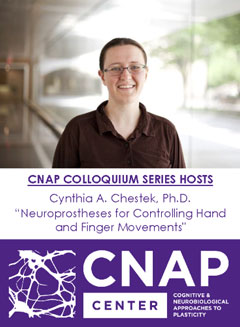February 21, 2024
Cynthia A. Chestek to present ‘Neuroprostheses for Controlling Hand and Finger Movements’

Cynthia Chestek, from the University of Michigan, Ann Arbor, will present a talk titled "Neuroprostheses for Controlling Hand and Finger Movements" from 3:30-4:30 p.m. Wednesday, Feb. 28, in the Engineering Hall Auditorium, Room 1109.
Chestek is hosted by K-State's NIH-funded Phase II COBRE Center for Cognitive and Neurobiological Approaches to Plasticity, or CNAP, as part of the center's 2023-2024 colloquium speaker series. This series is designed for specialists and non-specialists alike and invites leading experts to cover topics related to neural plasticity — the changing brain. CNAP invites the K-State community to join them in expanding their knowledge of neuroplasticity and brain function.
Chestek received her bachelor's and master's degrees in electrical engineering from Case Western Reserve University in 2005 and her doctorate in electrical engineering from Stanford University in 2010. She is an associate professor of biomedical engineering and robotics at the University of Michigan, where she joined the faculty in 2012. Chestek runs the Cortical Neural Prosthetics Lab, which focuses on brain and nerve control of finger movements as well as high-density carbon fiber electrode arrays. She is the recipient of several NIH R01 awards and the author of 87 full-length scientific articles. Her research interests include high-density interfaces to the nervous system for the control of multiple degree of freedom hand and finger movements.
Presentation abstract: Brain-machine interfaces or neural prosthetics have the potential to restore movement to people with paralysis or amputation, bridging gaps in the nervous system with an artificial device. Performance can already surpass the current state of the art in assistive technology in terms of controlling the endpoint of computer cursors or prosthetic hands. For example, for people with upper limb amputation, we can acquire signals from individual peripheral nerve branches using small muscle grafts to amplify the signal. We have also developed carbon fiber electrodes that are similar in size to the neural cells, leading to minimal scarring after implantation. The natural next step in this progression is to control more complex movements at the level of individual fingers. The long-term goal of this work is to make neural interfaces for the restoration of hand movement a clinical reality for everyone who has lost the use of their hands.
